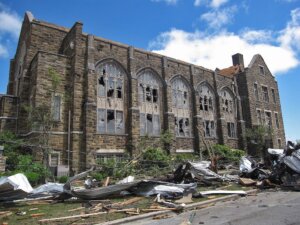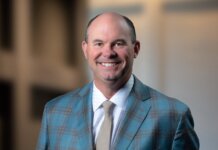
Mike Rogers doesn’t just build buildings — he revives stories, breathes life into forgotten spaces and rewrites the narrative of a city that for decades was known more for its “potential” than its progress.
A Mobile native and Auburn University graduate, Rogers has spent a good part of the last 35 years shaping the cityscape of his hometown. Through his company, Rogers & Willard, and his parallel venture, Porchlight, which brings together resources for community redevelopment projects, he’s helped restore some of Mobile’s most iconic — and long-abandoned — structures. But it didn’t begin with blueprints and backhoes. It started with heart pine.
“My father loved old buildings,” Rogers recalls. “He had a real love of heart pine, so every time they’d be tearing down an old barn or an 1800s house in the country or something, he’d ask if he could have the wood. He’d save it and build things out of it.”
That appreciation would later define one of Rogers’ signature strengths: historic restoration. Though not an intentional business niche from the start, it has become a cornerstone of his firm’s identity. After a few commercial jobs put Rogers & Willard on the map in the early 1990s, the company’s reputation for tackling complicated projects grew — and so did opportunities to save old buildings from the wrecking ball.

The Buick Building and the Birth of a Tech Corridor
A turning point came in 2012 with the acquisition of the long-abandoned Buick Building on St. Louis Street. At the time, the once-grand corridor was a shell of its former self — a downtown street flanked by boarded-up warehouses and automotive relics.
“We bought a city block and a 40,000-square-foot building for $220,000, and we sat on it a couple of years, trying to figure out what we were going to do,” Rogers says. “It had been vacant for 15 years.”
Rogers found his answer when a tech company, Rural Sourcing, approached him. If he could restore the building, they’d move in. He did — and he moved his own office there, too.
What followed was a snowball of restoration. The Buick Building received Alabama’s highest preservation honors and national recognition from the National Park Service. More importantly, it catalyzed change. Other buildings on St. Louis Street followed suit. What was once known for car dealerships in the 1920s and ’30s became known again — as “Automobile Alley,” now a registered historic district and one of Mobile’s liveliest redevelopment corridors.
The city’s current $16 million streetscape overhaul of St. Louis Street, complete with buried utilities and pedestrian-friendly amenities, is a direct result of that early vision.

Crafting the Past for the Future

Rogers never intended to specialize in historical work — he simply followed where his interests and the opportunities led. From early renovations at Alabama Shipyard to restoring the tornado-ravaged First United Methodist Church in Cullman, his company’s resume grew organically.
But it’s in projects like the current restoration of the Dave Patton House that his passion for preservation is most evident. The late 19th-century home belonged to one of Alabama’s earliest Black entrepreneurs and was designed by renowned architect George Rogers. It now sits at the center of Mobile County’s new Civil Rights and Cultural Heritage District.
“We’re restoring it as part of that effort,” Rogers says.
Another current project is the Chighizola House, an 1840s structure that Rogers & Willard is restoring. Once the renovation is complete, it will be Mobile Bay magazine’s Inspiration Home in March 2026.
Restoring historic structures comes with its own challenges, from navigating federal and state preservation standards to sourcing out-of-production materials, but it’s a creative puzzle Rogers enjoys solving.
“A lot of times the materials used originally aren’t readily available,” Rogers says. “You’ve got to go try to find old brick or old stone or old hardware or appropriate lighting, so nothing is really easy. … The (Chighizola House) is probably one of the harder ones I’ve ever done. It’s been a real challenge adding air conditioning and electricity and plumbing and figuring out how to do that without anyone seeing any of the ductwork.”
But the challenge is worth it when the puzzle is solved.
“One of the most rewarding things,” he says, “is when you take a building that’s been vacant for 10, 15, 20 years, and it comes alive with people.”

Part of Mobile’s Moment
Even as his company looks back to restore the past, Rogers is relentlessly looking forward, whether it’s with restoration projects, new builds, churches, schools, restaurants – Rogers & Willard is involved in an array of different kinds of projects.
Over the last five years, the company has seen its annual revenue grow from a consistent $30-50 million to closer to $70 million, and the company is embracing new technology.
That drive for innovation is baked into the company’s core values, which include “Relentless Progress,” “People Matter Most” and “Do the Right Thing, Whatever It Takes.”
More than three decades into the business, Rogers, whose wife, Cay, is a residential contractor, is thinking about what comes next — not just in terms of projects, but people. Succession planning is underway, and the company is grooming its next generation of leaders.
As much as Rogers has changed Mobile, he’s quick to credit the city for changing, too. For years, locals called it “the city of perpetual potential.” Now, Rogers believes that era is ending.
“We’ve got young people moving back again, and there’s a lot happening,” Rogers says. “We’ve got a long way to go, but I feel like we’re doing well. It has been fun to be part of that.”
Alec Harvey is executive editor of Business Alabama. He is based in the Birmingham office.
This article appears in the June 2025 issue of Business Alabama.



